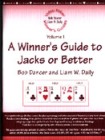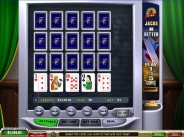
Winner's Guide Volume 1: 2nd Edition - Jacks or Better
Bob Dancer and Liam W. Daily have just released the second edition of Winner's Guide Volume 1 -- Jacks or Better. This new edition has been expanded to 128 pages and features the following enhancements: 1) A complete discussion of the differences between Jacks or Better and other popular games, including Double Bonus, Double Double Bonus and Deuces Wild. 2) Enhanced (more user-friendly) notations --- done in conjunction with the latest Dancer/Daily Strategy Cards. 3) An updated strategy for Level 4 Flush-5
With these improvements, Winner's Guide Volume 1 presents the most comprehensive discussion of Jacks or Better ever published.
How to Calculate Breakeven Points
You are playing dollar 9/6 Jacks or Better. You are dealt As Ts Jh 6c 4d. The proper play is to hold AJ, because the $EV (dollar expected value, which is the amount the combination is worth when Bob Dancer is one of the world's foremost video poker experts. He is a regular columnist for Casino Player, Strictly Slots, and the Las Vegas Review-Journa land has written an autobiography and a novel about gambling. He provides advice for tens of thousands of casino enthusiasts looking to play video poker. Bob's website is www.bobdancer.com you are betting five $1 coins) of AJ is $2.37 and the $EV of AT is only $2.25. But now let's assume you are playing the same game with a royal of $8,000 rather than $4,000. This will increase the value of AT to $2.49 but leave the value of AJ as it was. Now AT is the right play
Bob Dancer is one of the world's foremost video poker experts. He is a regular columnist for Casino Player, Strictly Slots, and the Las Vegas Review-Journa land has written an autobiography and a novel about gambling. He provides advice for tens of thousands of casino enthusiasts looking to play video poker. Bob's website is www.bobdancer.com you are betting five $1 coins) of AJ is $2.37 and the $EV of AT is only $2.25. But now let's assume you are playing the same game with a royal of $8,000 rather than $4,000. This will increase the value of AT to $2.49 but leave the value of AJ as it was. Now AT is the right play
The amount of the royal flush where AJ and AT are exactly equal in terms of expected value is called the Breakeven Point, or BP. To my knowledge, Stanford Wong in his Professional Video Poker was the first to use this term, although he abbreviated the term as BEP rather than the BP I prefer. Wong's book was on 8-5 Jacks or Better Progressive, but the theory behind BP is the same in other video poker games as well.
BP analysis is typically done in terms of COINS, but it's a lot more useful when done in terms of DOLLARS AND CENTS. In this I am going to use dollar denominated games. 4,000 coins is, of course, $4,000. If you play for nickels, quarters, half-dollars, $2, $5 or higher, it is a simple matter to multiply the dollar BPs by the appropriate factor.
The goal of BP analysis on a hand like this is to determine the value of the royal flush where the $EV of AJ will be identical to the $EV of AT. How much will that $EV be? It will be $2.37, of course, because the $EV of AJ is ALWAYS $2.37. Let's see how we calculate this.
The formula for the calculation of $EV is not very difficult. It is, simply, DRF = C x D$EV. Of course the symbols all need to be defined, so let's do that now. Does the funny looking triangle look like Greek to you? It should. IT IS GREEK! Actually it is the capital Greek letter "delta", which is the symbol mathematicians usually use to indicate "the change in". So DRF simply means the change in the value of the royal flush, and D$EV means the change in the value of the dollar expected value.
The symbol C stands for the number of possible combinations. "Combination" is an everyday term, but it also has a precise mathematical definition. Here we mean the number of unique draws we could make from a starting position, IF ORDER DOESN'T MATTER. That is, if we draw three cards (like we are doing in this example), the draw Ac 5h 3s is considered exactly equivalent to Ac 3s 5h, or 3s Ac 5h or any of the three additional permutations. The possible values of C will be:
178,365 for a 4-card draw
16,215 for a 3-card draw
1,081 for a 2-card draw
47 for a 1-card draw
Regular readers of my writing are familiar with these numbers. For a 52-card game, these numbers remain constant.
To get $EV we need a computer program. Using Bob Dancer Presents WinPoker, go to 9/6 Jacks or Better with a royal flush of 4,000. Make sure you are on "max bet", and then go to "analyze any hand."
Enter the hand As Ts Jh 6c 4d and look at the numbers. AJ appears on the top line, and the first number you see is 2.3716. This is the $EV. AT appears a few lines lower, and the first number you see there is 2.2498. Earlier I rounded these numbers off to 2.37 and 2.25, but for BP analysis we want to use the extra significant digits.
Since we are drawing three cards to AT, our formula now becomes
DRF = 16,215 x (2.3716 2.2498)
DRF = 16,215 x (0.1218)
DRF = 1975 (rounded)
This means we add $1,975 to the original $4,000 and come up with a BP of $5,975. When the royal flush is lower than $5,975, hold AJ. When it is above $5,975, hold AT. When it's exactly $5,975, flip a coin.
If you don't trust your math, go back to BDPW and change the pay schedule of 9/6 Jacks so that 5975 is the amount of the 5-coin royal. If you do that, and enter the ATJ64 we've been talking about, you'll see that both AJ and AT have the same value, and it is $2.3716.
BPs are tedious. And there are a lot more of them than you might think. Our first example seemed easy enough, but the number would have been different if the 6c had been the 6s. The $EV of AJ wouldn't have changed, but the $EV of AT would be LOWER because there are fewer flush opportunities once the 6s is thrown away. And comparing AT to AJ is different from comparing AT to A by itself. And when you talk about A versus AT, there are a lot more penalty card situations to consider. One or two low cards (i.e. 2 through 5) affect the value of the A. A low spade affects the value of the A even more because it prevents the A2345 straight flush from occurring.
The only way to check to see if you understand this is to try a few hands. I suggest you try the following three hands. I'll give you the answers next week.
a. Kh Qh Jh Js 5c --- when is KQJ preferred over JJ?
b. Kh Qh Jh Js 5h --- when is KQJ preferred over JJ? (This is NOT the same question as before).
c. Js Ts 7s 5h 3c --- when is JT preferred over JT7?

